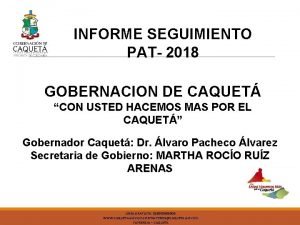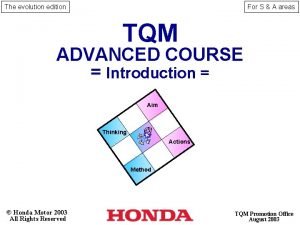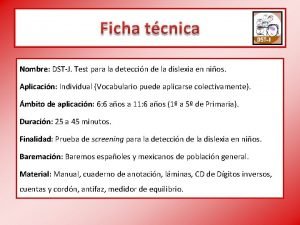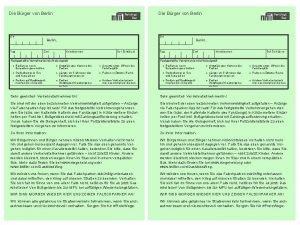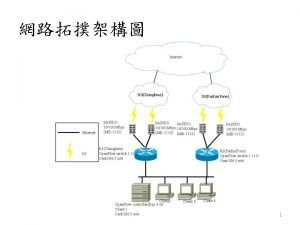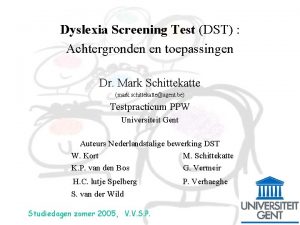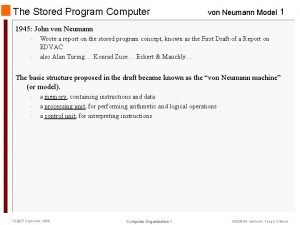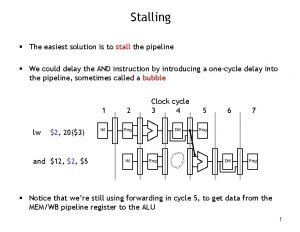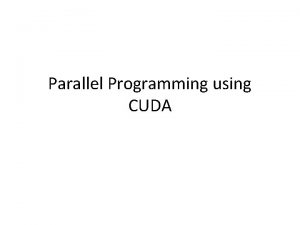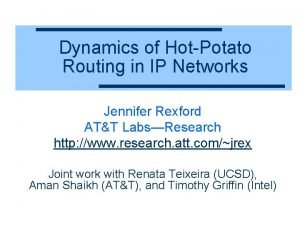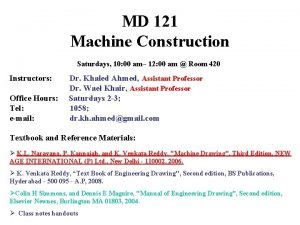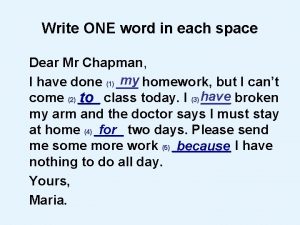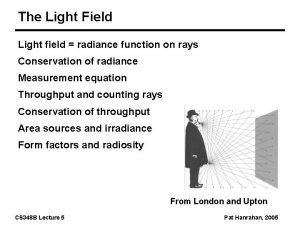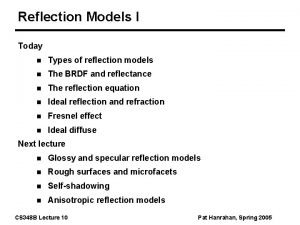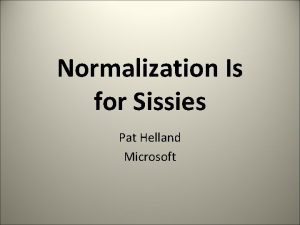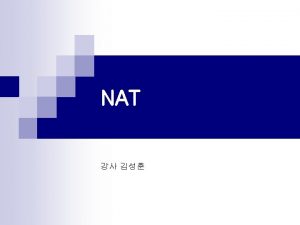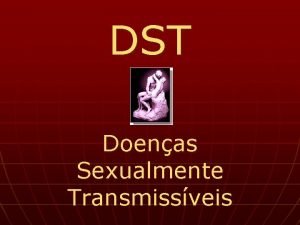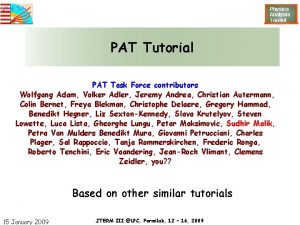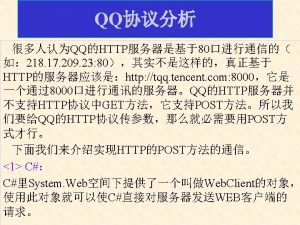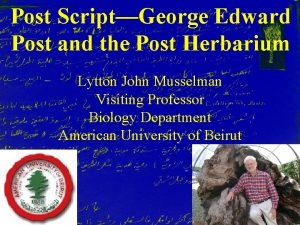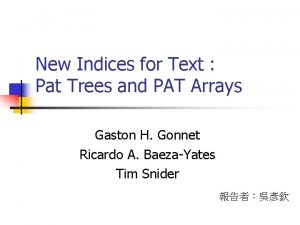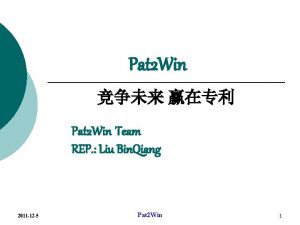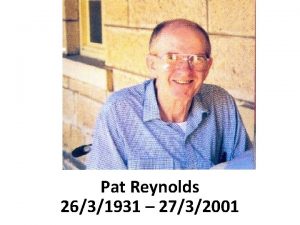PAT Post DST Analysis Tool A tool which





































- Slides: 37

PAT – Post. DST Analysis Tool A tool which brings you closer to your dedicated physical analysis making some intermediate analysis steps very easy but this is not the tool you draw your final histograms with Each piece of software has some features and limitations! Very generic program leaves people helpless and the time necessary to ”understand” and ”configure” it is usually unacceptable Rapid analysis development and immediate effects Simple no deep programming knowledge (unless you really want to change the code) In most cases you will need to change only a few lines of code (define particle combinations and provide your (i. e. graphical) cuts in ROOT files. If your analysis is very specific and goes beyond that tool can provide, do not hesitate to ask how to alter the code

How the data circulate in HADES Experiment Simulation sim DST ( hit & track reconstruction ) ”hard cuts” ”Bayesian” HYP PAT Ti. Fini PLUTO ( HSD, Ur. QMD, IQMD, BRo. BUU ) GEANT ( full particle tracking and detector response ) FAT final analysis tool FILTERING ( acceptance, spectrometer resolusion, efficiency ) publication, conference, Ph. D

PAT - general idea �Intermediate analysis tool select �From HPid. Track. Cand(Sim) – DSTwhat level you want and �Until any combination of single tracks have it in the combinatorics done automatically output file with no extra care! �Information propagated � Common event data � Full set of particle data � Automatic data flow from the beginning till the end � Minimum (or none) of code to be written by the user � Full �The last part (very specific physical analysis) has to be written and understood by the user!

Example 1 HNtuple – simple data tree �Location: lib. Hydra. so (HYDRA), but for training now: �Download source code (HNtuple. tar. gz): http: //hades-wiki. gsi. de/cgibin/view/Homepages/HNtuple �In PAT you will define your particle set (a combination from 1 to 4 particles) with a label �The label will become automatically an NTuple name �You will select the variables to be stored always with the method set( ”any_name”, value ) �Automatic data propagation till the output file �No need to book explicitly any ntuple, no need to take care of data once they have been selected

Example 2 PAT – compile the source code �Location: (not in HYDRA so far) �Download source code (PAT_5 th. Summer. School. tar. gz): http: //hades-wiki. gsi. de/cgibin/view/Homepages/PAT �For this training only the core and the user parts are together (because the code is not in HYDRA yet) �The core part of the source code (it will be a library) is supposed not to be changed unless necessary �The user part is the place to define what to analyze and which selections, cuts etc. to apply �User is responsible for cut definition (i. e. you have to draw your own graphical ”banana” cuts)

Basic data units HParticle. Candidate HParticle Container with a set of useful particle parameters, copied from HPid. Track. Cand, (or HPid. Track. Cand. Sim) selected by the user. Auto-recognition if data are simulation and copying additional set of data. Storing a variable is as easy as: set("label” , variable); called in the constructor. HHyp. Candidate For example: set("rich_amp", p. Hit->get. Ring. Amplitude( and since then "rich_amp" is propagated to all higher data levels.

FAQ Where and how can I add or remove data of my interest? �Open file: 0. hparticlecandidate. cc set("id", ); set("sector", Hit. Data->get. Sector() ); Here we set("system", Hit. Data->get. System() ); recognize the set("p", Track. Data->get. Momenta(4) ); simulation! // … and so on … HPid. Track. Cand. Sim *Pid. Cand. Sim = dynamic_cast<HPid. Track. Cand. Sim*>( ptr ); if ( Pid. Cand. Sim != 0 ) { HPid. Geant. Track. Set* ptr. Sim = Pid. Cand. Sim>get. Geant. Track. Set(); set("sim_iscommon", ptr. Sim->get. Most. Common. Correlation() ); set("sim_id", ptr. Sim->get. Geant. PID() ); �Any data is just a matter of a line of code with ”set” method. �This is core code modification but very easy!

FAQ Where is HParticle. Candidate object added? Can I get data also from the other categories? (i. e. HWall. Hit or HMdc. Clus. Inf)… �Open file: hparticlepool. cc and hparticledatapool. cc void HParticle. Pool: : loop(HIterator* data. It)HParticle. Data. Pool: : add. Part. Cand { // … (EParticle e. Id, HPid. Track. Cand *ptr. C) { if (Pid. Cand->is. Flag. Bit(HPid. Track. Cand: : k. Is. Used) == 1) add. Part. Cand(my. EId, Pid. Cand); HParticle. Candidate *ptr = new HParticle. Candidate(ptr. C); �Similarly it is possible to add HWall. Hit information (for example another version of HParticle. Candidate constructor). To any HParticle. Candidate object one can add more data (i. e. from HMdc. Clus. Info) with the ”set” method. �However, this requires core code modification, therefore please call me for help!

Basic data units HParticle. Candidate HParticle HHyp. Candidate Wrapper to HParticle. Candidate class pointers. Because the combinatorics is done on pointers (different combinations with the same pointers set) this class allows to overwrite existing variables and add new variables. For example: Each HParticle. Candidate object has a prefix defining the particle species, like hpos – positive hadron, lneg – negative lepton etc. Hadron can then be a proton or or a π+, therefore in HParticle the new particle id shadows the ”old” one.

Example 3 HParticle – a wrapper �Open file: hparticle. cc HParticle: : HParticle(HParticle. Candidate *p. C) : p. Cand(p. C) { set("id", p. Cand->get. EId() ); set("track_length", -1. ); Here we overwrite the id value set("tof_mom", -1. ); and add new variables not set("tof_new", -1. ); present in HParticle. Candidate set("beta_new", -1. ); } �HParticle object contains (a pointer to) HParticle. Candidate but also it has an independent list of data (name – value) �User can add new data or overwrite ”old” data (from HParticle. Candidate) and the new value will be streamed to the output. HParticle. Candidate object is not changed

Basic data units All basic units are kept in the higher data level: pools. HParticle. Candidate HParticle HHyp. Candidate A combination of particles of a given pattern. Combination has a name (label) and a set (array) of pointers to HParticles. Each ”hypothesis” has a pointer to a pattern it represents. The container stores one set of combined particles and collection of such objects will keep all combinations.

Example 4 HHyp. Candidate – set of particles �Open file: hhypcandidate. h class HHyp. Candidate : public TObject { //. . . protected: An array of particles (pointers) Particle. Cand. Seq n. Part; of a given combination based Particle. Cand. Seq. Iter part. Iter; on a pattern HPattern *p. Pattern; �There are many places in the code where I use typedefs of some types, i. e. : Particle. Cand. Seq. All these (typedef) definitions you can find in the file hcommondef. h typedef std: : vector< HParticle* > Particle. Cand. Seq; �If you want to read (understand, change…) the core code I recommend to print hcommondef. h file!

FAQ What is the ”HPattern” to which HHyp. Candidate refers to? �Open file: hpattern. h Really open it (there are too many lines to copy/paste here) �HPattern object is very important (in the core code)! �It holds the pattern of user defined particle combinations, i. e. pp, e+e-, pppi+pi-, K+K- etc. �It holds the output (if defined), books the ntuple, passes the data to the ntuple, calls filling the ntuple �User can also define the prefix or suffix to any data label, this way i. e. momentum (labeled ”p”) is automatically supplemented with the particle type, i. e. ”ep_p” for positron

Data pools Collections of particle candidates, sets of particles… HParticle. Data Pool HParticle. Po ol HHyp. Pool Direction of the analysis HHyp. Data. Po ol HPid. Pool

Example 5 HPool – define your pattern �Open file: hpool. h Set of common (event) data, i. e. class HPool { public: event number, HPool(HOutput. File *ptr = 0); multiplicity, event vertex… virtual ~HPool() = 0; //. . . bool add(const char* name, EParticle p 1); bool add(const char* name, EParticle p 1, EParticle p 2); // … and so on protected: HEvent. Pool event. Data; std: : list<HPattern*> object. List; �Any ”pool” is a data structure streamed to the output file (if defined). User defines here patterns: all particle combinations (method ”add”) – name (label) and particle species (number of particles from 1 to 4).

Data pools HEvent. Pool Container for keeping the common event information (event number, particle multiplicity, event vertex information etc. ). Object of this type is present in every data pool and propagated to the next one. At each higher data level (data pool) you can add more information to the HEvent. Pool. It will be then automatically streamed to the output file.

HParticle. Data. Pool Multi. Particle part. Cand; typedef std: : multimap< EParticle, HParticle. Candidate* > Multi. Particle; Particle. Num part. Num; typedef std: : map< EParticle, int > Particle. Num; e HHyp. Data. Pool Multi. Hyp P the art of cod hyp. Cand; typedef std: : multimap< std: : string, HHyp. Candidate* > Multi. Hyp; Hyp. Num hyp. Num; typedef std: : map< std: : string, int > Hyp. Num;

Data pools Container for various particle candidates like +/- hadrons, +/- leptons first, then particles: p, π+, π-, e+, e- and so on. HParticle. Pool HHyp. Pool HPid. Pool Defining your combination pattern: HParticle. Pool my. Particles( &output. File ); my. Particles. add(„all", e. Hadron. Pos, e. Hadron. N e. Lepton. Pos, e. Lepton. Ne For example: You can also define a smaller subset, i. e. only lepton candidates. Particle species are decided based on tracking (Runge Kutta) information. Positive/negative polarity means +/ – particle, correlation with a RICH ring means lepton.

Data pools Important: each data pool can be stored in the output file. HParticle. Pool HHyp. Pool HPid. Pool During copying particle (track) information from HPid. Track. Cand a track cleaner decision is taken into account in order to reduce garbage tracks (killing the performance and the signal). You can change it, i. e. to take all particle candidates. Later, a cut (window between RICH / MDC) for leptons additionally checks correlation. If a ring and a track are outside the cut, the track returns to hadrons.

Example 6 HParticle. Pool – first step in data flow �Open again file: hparticlepool. cc data. It->Reset(); while (((Pid. Cand = (HPid. Track. Cand *) data. It->Next()) != 0)) { is. Positive = ( Pid. Cand->get. Track. Data()->get. Polarity(4) > 0 ) ? k. TRUE : k. FALSE; is. Ring = Pid. Cand->get. Hit. Data()->get. Ring. Correlation(4); EParticle my. EId; if (is. Positive && is. Ring) my. EId = e. Lepton. Pos; else if (is. Positive && !is. Ring) my. EId = e. Hadron. Pos; else if (!is. Positive && is. Ring) my. EId = e. Lepton. Neg; else if (!is. Positive && !is. Ring) my. EId = e. Hadron. Neg; �Preliminary particle selection (positive/negative, hadron/lepton) �Limit on the maximum multiplicity of a given particle species �Only good tracks (based on track cleaning procedure) taken

Data pools HParticle. Pool HHyp. Pool HPid. Pool Container for HHyp. Candidates, each of them has a name (label) and a set (array) of pointers to HHyp. Candidate object. Defining your combination pattern: HHyp. Pool my. Hyps( &output. File ); my. Hyps. add("Lp. Lm", e. Lepton. Pos, e. Lepton. Ne my. Hyps. add(„Hp. Hp", e. Hadron. Pos, e. Hadron. Po For example: You give a label and list of particle species (from 1 up to 4). Here (HHyp. Pool) we do not know particle id yet, only if it is positive or negative, lepton or hadron.

Data pools HParticle. Pool HHyp. Pool HPid. Pool Full combinatorics is done automatically. In each event you have N particles and following the user pattern all combinations (1, N), (2, N), (3, N) or (4, N) are done. The limit (N<30 of a given particle type) is for performance reasons only. You can define in parallel as many combination patterns as you want and each pattern will have the separate ntuple output to the file.

Example 7 HHyp. Pool – particle (but no id) combination �Open again file: hhyppool. h private: int count(HPattern *ptr. C, HParticle. Pool& ref. PPool); void combine(HPattern *ptr. C, HParticle. Pool& ref. PPool); std: : vector<HHyp. Candidate*> hyp. Set; �Full combinatorics (N choose k) is done here �Method ”count” calculates how many combinations of a given pattern are possible in a given event (taking particles from HParticle. Pool) �Method ”combine” does all combinations and stores them in the array of HHyp. Candidates (here hyp. Set)

FAQ How the combinatorics is done? Is it k-element subset of N-element set with the order irrelevant? �The order is relevant if you have more than one particle of a given species. Keep in mind that you do your particle combination first on a level of generic particle selection, i. e. H+, H-, L+, L- (H – hadron, L – lepton). �For example, H+H+ (two positive hadrons) can become i. e. proton-proton (and you need to avoid double counting by selection of one combination) or proton-pi+ (then it is important which hadron is really proton/pion, 1 st or 2 nd). �Open file: hhyppool. h and see #define COMB_REPETITION 1 what means that choosing particles with repetition is active.

Data pools HParticle. Pool HHyp. Pool HPid. Pool Container for HHyp. Candidates, but now all particle candidates are assigned to be real particles. Defining your combination pattern: HPid. Pool my. Pids( &output. File ); my. Pids. add("Lp. Lm", "Ep. Em", e. Positron, e. Ele my. Pids. add("Hp. Hp", "PP", e. Proton); my. Pids. add("Hp. Hp", "PPip", e. Proton, e. Pi. Plus For example: The action between HHyp. Pool and HPid. Pool is usually applying user cuts making time (beta) recalculation, PID selection etc. You can define as many HPid. Pool objects with various cutting scenarios as you want.

Example 8 HPid. Pool – various id scenarios �Suppose we have defined combination of 2 positive hadrons. HHyp. Pool my. Hyps; my. Hyps. add("HH", e. Hadron. Pos); Feeding from the same combination we can define which particles we actually want to have in the combiantion: HPid. Pool my. Pids( &output. File ); my. Pids. add("HH", "PP", e. Proton); my. Pids. add("HH", "PPip", e. Proton, e. Pi. Plus); �These ”e. Something” names are just enumeration type labels to be found in hcommondef. h file: e. Unknown=0, e. Positron=2, e. Electron=3, e. Pi. Plus=8, e. Pi. Minus=9, e. Proton=14, e. Lepton. Pos=102, e. Lepton. Neg=103,

FAQ Ok, we have got a bunch of particle combinations, possibly more than one per event. Which is the best? �The best combination needs to have a parameter distinguishing it from the other combinations. Usually this is 2 calculated elsewhere (i. e. in a user cut or selection). �In elementary collisions I reconstruct the time of flight and calculate 2 (provided also detector time resolution). Then in HPid. Pool: : fill() I loop over all combinations of a given pattern and select that one with the lowest 2 �Then I add a new data field: event. Data. set( "is. Best", 1 ); // or 0 if not the best �Sometimes we want more than one ”the best” combination – this happens in the case of acceptance/efficiency matrix production with many white (good) tracks per event. In this case call me for help (in order to change slightly the code).

Reconstructos (players) HTrack. Player HParticle. Player HHyp. Player Reconstructor acts between DST data (HPid. Track. Cand, HPid. Track. Cand. Sim) and HParticle. Pool. Defining reconstructor: HTrack. Player * hyp = new HTrack. Player( my. P For example: Usually here you want to define your fine particle (track) candidate selection, i. e. apply some narrower correlation window for your leptons or do some track cleaning.

Reconstructos (players) HTrack. Player HParticle. Player HHyp. Player At each reconstructor user can add a list of cuts to be done between data levels. Reconstructors act between HParticle. Pool and HHyp. Pool, and between HHyp. Pool and HPid. Pool, respectively. Defining reconstructors: HParticle. Player * hyp 2 = new HParticle. Player(my. Particles HHyp. Player * hyp 3 = new HHyp. Player(my. Hyp

Example 9 HHyp. Players – various scenarios �It is important to understand that a player (reconstructor) is a place where you add your cuts (as many as you want and in any order). It is convenient then to investigate the influence of a given cut just by creation of different final HHyp. Player reconstructors (which target different final HPid. Pool objects) �HPid. Pool my. Pids_A( &output. File ); my. Pids_A. add("HLp. Lm", "PEp. Em_ID", e. Proton, e. Positron, e. Electron); HPid. Pool my. Pids_B( &output. File ); my. Pids_B. add("HLp. Lm", "PEp. Em_DEDX", e. Proton, e. Positron, e. Electron); HHyp. Player * hyp 3_A = new HHyp. Player(my. Hyps, my. Pids_A); HHyp. Player * hyp 3_B = new HHyp. Player(my. Hyps, my. Pids_B);

Cuts HCut HTrack. Cut HTime. Cut HGraph. Cut HDedx. Cut User is responsible to write his/her own cuts (algorithms how to deal with data). Base (interface) class. It can open and retrieve as many files and cuts (TH 1* and TCut. G* objects) as you may need. Cuts can be applied in any order and at any reconstructor (that is, between two consecutive data levels). Some standard cuts are provided.

Cuts have labels! If you choose ”all” the cut will be applied to all patterns (combinations) of a given data pool. If you name it i. e. ”Ep. Em” it will be applied only to a pattern with the same label! HCut HTrack. Cut HTime. Cut HGraph. Cut HDedx. Cut Defining and adding cuts: HTrack. Cut t. Cut("all"); HGraph. Cut t. Cut 2("all", "M 3_PIDCUTS. root"); hyp->add( t. Cut ); hyp 3 ->add( t. Cut 2 ); For example: Cuts are written in the user directory, all have to be derived from HCut class. The user links with the lib. Pat. so library. No changing the base code! (future: not during this training)

Example 10 HTrack. Cut – fine hadron/lepton selection �The cut is meant to act on HParticle. Pool �HParticle. Pool objects are filled from HPid. Track. Cand but the lepton selection is based on quite large correlation window (RICH –MDC). �It is necessary to make a finer correlation. User has to draw versus sin • (where = RICH – MDC, = RICH – MDC) and prepare parameterization of an elliptic correlation window (as a function of momentum) �HTrack. Cut checks the correlation for lepton candidates and if there is no track correlation with RICH ring the candidate becomes again a hadron candidate. �If you open hhypdata. h file you will see a lot of numbers – this is some parameterization for pp@1. 25 Ge. V, prepare your own!

Example 10 HTime. Cut – time reconstruction �The cut is meant to act on HPid. Pool �In elementary reactions measured by means of a HADES spectrometer we often ; -) had no START detector therefore no absolute time calibration �Only relative time between particles is available therefore at least two particles are necessary (in experiment this is the case but in simulation with ”single tracks” – not) �All particles can be taken as ”reference” particle but with some priorities (hit in TOF better than in TOFino, lepton better than hadron) �Important: in this cut I calculate 2 (chi 2) which is a parameter of further the best combination selection. If you do not reconstruct the time you have to calculate 2 anyway.

Example 11 HGraph. Cut – graphical cut for PID �The cut is meant to act on HPid. Pool �Definition of the object requires also a file containing the cuts HGraph. Cut t. Cut("all", "MY_PIDCUTS. root"); �HGraph. Cut has usually pointers i. e. TCut. G *p_cut; which are assigned to cuts read from file in the constructor, i. e. p_cut = get. Cut("p_cut"); �Selection is just based on a check if (p_cut) return p_cut->Is. Inside( beta, mom ); for all particles in a combiantion. �If any of these checks fails, the HHyp. Candidate object is deactivated: p. Hyp->set. Active( false ); �Exactly the same for HDedx. Cut �Hint: name your cuts with p_cut, em_cut and so on, and

Life example This is only part of the code relevant to the PAT configuration. The rest see main. cc HOutput. File output. File( "test. root” , "recreate" ); HParticle. Pool my. Particles; //HParticle. Pool my. Particles( &o my. Particles. add("all", e. Hadron. Pos, e. Hadron. Neg, e. Lepton. Po HHyp. Pool my. Hyps; //HHyp. Pool my. Hyps( &output. File ); my. Hyps. add("HLp. Lm", e. Hadron. Pos, e. Lepton. N my. Hyps. add("HLp. Lp", e. Hadron. Pos, e. Lepton. Po my. Hyps. add("HLm. Lm", e. Hadron. Pos, e. Lepton. Neg, e. Lepton. N HPid. Pool my. Pids( &output. File ); my. Pids. add("HLp. Lm", "PEp. Em", e. Proton, e. Positron, e. Electr my. Pids. add("HLp. Lp", "PEp. Ep", e. Proton, e. Positro my. Pids. add("HLm. Lm", "PEm. Em", e. Proton, e. Electron, e. Elec HTrack. Player * hyp = new HTrack. Player( my. Particles ); HParticle. Player * hyp 2 = new HParticle. Player(my. Particles, HHyp. Player * hyp 3 = new HHyp. Player(my. Hyps, my. Pids); HTrack. Cut t. Cut("all"); HGraph. Cut t. Cut 2("all", "M 3_PIDCUTS. root"); hyp->add( t. Cut ); hyp 3 ->add( t. Cut 2 );

S u m m a r y • PAT can be used in any analysis where you have a certain particle (1 -4) combination • There is full event information available you can reconstruct your data on event basis • Easy to adjust any kind of reaction to analyze • All reactions processed in one run • You can write the output to more than one file • Full combinatorics done automatically • Easy to add any variables to be stored • Time recalibration option, PID cuts, d. Edx cuts… • Output: optional on any level: ntuples • If you want to investigate more than one combination in parallel (i. e. make them dependent event by event) it is possible but you have to write your piece of software (FAT – final analysis tool ) which reads ntuples entry by entry, checks event number and does the correlation (selection).
 Pat pat seguimiento
Pat pat seguimiento Honda tqm
Honda tqm Test dstj
Test dstj Define ergogenic aids
Define ergogenic aids Dst concept
Dst concept Dst schlüssel berlin
Dst schlüssel berlin Src mac
Src mac Cantor fitzgerald dst
Cantor fitzgerald dst Paralleltestmethode
Paralleltestmethode Dst csri
Dst csri Modello von neumann
Modello von neumann Stall on branch
Stall on branch Cuda
Cuda Sanjay bajpai dst
Sanjay bajpai dst Nkust dst
Nkust dst Nsw dst
Nsw dst Dst potatoes
Dst potatoes Dst 指令
Dst 指令 Pat score chart
Pat score chart Same song pat mora
Same song pat mora Pqwg
Pqwg Rear tool post
Rear tool post Complete the text. write one word in each space
Complete the text. write one word in each space Pat oliphant cartoon archive
Pat oliphant cartoon archive Examples of allophones
Examples of allophones Pat coso
Pat coso The princess pat lyrics
The princess pat lyrics Pat coso
Pat coso Pat arnott
Pat arnott Cat pat phase 1 examples grade 10
Cat pat phase 1 examples grade 10 Pat v. villafuerte mga akda
Pat v. villafuerte mga akda Ohio risk assessment
Ohio risk assessment Pat helland
Pat helland N2nnn transistor
N2nnn transistor What is nat
What is nat Golden bricks writing
Golden bricks writing Pat has atnie
Pat has atnie Pat orr
Pat orr
